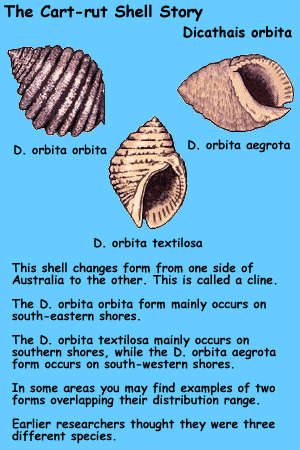|
|

Cart-rut Shell Story
The story of the Cart-rut shell is an interesting one. When Europeans came to Australia they thought it was a land of wonder. It was quite different to anything in Europe where they came from. In every capital city in the new states they set up Museums, and researchers went out to try and find out about all the interesting animals and plants that they found. It was all so new to them. In Sydney, at the Australian Museum, the shell-collectors, called Mallacologists, found a large carnivorous shell on their shores. Because it had deep grooves around its shell, and it resembled the narrow, deep wheel ruts of the horse and carriage vehicles of the day, they named it the Cart-rut Shell, Dicathais orbita. |
 |
In Melbourne, at the National Museum, the Mallacologists also found a large carnivorous shell on their southern shores which was much smoother, with a hint of the spiral ribs, which were quite irregular. So they named their shell the Dog Winkle, Dicathais textilosa.
In Perth, the Mallacologists found a third large carnivorous shell which didn't have any ridges at all, but was covered with low bumps called nodules and tubercles. They named their shell Dicathais aegrota. The word "aegrotat" means a certificate that a university student hands in when they are too sick to go to an examination. I wonder why this shell was named that.
When a single species gradually changes form from end end of its distribution range to another, is called a cline. In some species, such as the Black-headed Gull of the Northern Hemisphere, the species distribution goes all around the world, and the two end forms which now appear quite different to each other overlap their distribution range. Interestingly, these two forms do not mate with each other.
Chitons
False Limpets
Limpets
Top Shells
Nerites
Shell-less Molluscs
Turbans
Tritons
Murex Shells
Periwinkles & kin
Mussels
Siphon Shells
Bivalves
Home
Page
Taxonomy
Biogeography
Rocky Shores
Tidal Levels
Intertidal Zonation
Environmental Factors
Biological
Factors
Feeding Relationships
Activities
Glossary
References
 Life
on Australian Seashores
Life
on Australian Seashores
by Keith Davey (C) 2000
Learning Consultant
- Media
The University of Newcastle
email at australian_seashores@hotmail.com
Scientific Consultant: Phil
Colman
site created 01.01.98 : updated 01.04.2000